News All News
May 7th, 2019
Dream big, listen to the market, ask for help
10 key takeaways from OTD’s Bench-to-Business Boot Camp
By Caroline Perry
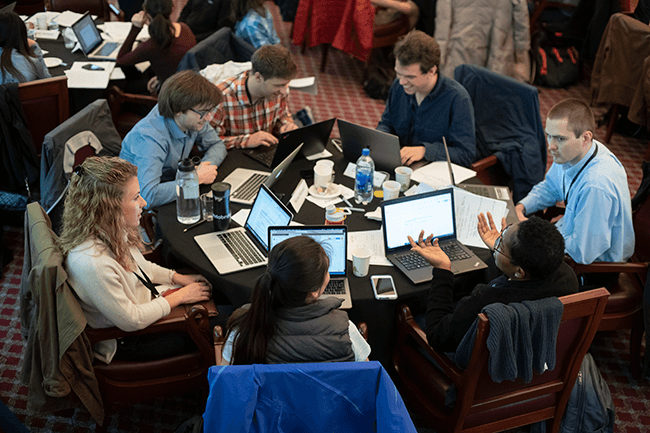
Photos from OTD's two-day Bench-to-Business Boot Camp © Tony Rinaldo.
Ever wondered how university innovations start the journey toward becoming products that the world can use? Very often, at Harvard, graduate students and postdoctoral researchers have a hand in it.
At the third annual Bench-to-Business Boot Camp, hosted by Harvard Office of Technology Development (OTD) on May 1–2, these early-career researchers gained the skills to engage confidently in the practice of technology commercialization and entrepreneurship.
The two-day workshop brought in 20 guest speakers to lead a series of interactive workshops, lectures, and panel discussions, exposing participants to the fundamentals — and the joy — of scientific innovation.
From over a hundred applications, 44 researchers from across the University were selected to participate, including 13 new OTD Business Development Fellows. For those who were unable to attend, we offer here 10 key takeaways from OTD’s Bench-to-Business Boot Camp.
1. Aim high.
When Kevin Eggan, Professor of Stem Cell and Regenerative Biology, began his career researching stem cells, it wasn’t clear where a supply of stem cells would come from, let alone how they might become useful in treating disease. Over the course of two decades of innovation, his lab’s work has now advanced to the point where somatic cells from patients with ALS have been turned back into stem cells, which have been differentiated into large quantities of motor neurons, creating a model system for the study of neurodegeneration in the lab, and ultimately enabling the development of a new therapeutic candidate to treat ALS. He is a cofounder of two companies, Q-State Biosciences and QurAlis.
“For myself, the thing that has been most productive has been to set my sight on something that’s just over the horizon,” Prof. Eggan said at the boot camp. “In that situation where you’re trying to do something that hasn’t been done before, or to take your research to new synthesis, it will often mean that you’ll be an early adopter of new technology or that you’ll innovate new technologies.”
2. Help OTD protect your intellectual property before you disclose it publicly.
University innovations can be immensely valuable to industry. “Companies are able to shave years off their development timelines when they in-license technologies from universities,” said Leslie Wardwell-Scott, PhD ’15, Senior Director of Corporate Development and Strategic Integration at Evelo Biosciences. She pointed to a study by researchers at Bentley University, who last year showed that every new drug approved by the FDA between 2010 and 2016 had arisen from the findings of NIH-funded research, mainly consisting of basic academic studies of the biological targets. Through the Bayh-Dole Act, the U.S. government assigns to universities the right to patent and commercialize inventions like these that arise from federally funded research, to ensure they’re developed to their full potential for society. That’s where OTD comes in.
Disclose your innovation to OTD so that it can be quickly evaluated for possible patenting before you publish the results, present at a conference, or livestream your ‘eureka’ moment. You’ll still get to share your ideas with the world: “You have to teach people how to make and use the invention,” said patent attorney David Resnick, Partner at Nixon Peabody. But the timing is essential. “It doesn’t take a lot to destroy your invention,” he said, and where prior art is concerned, “an abstract is more than enough to invalidate your patent.” Even if you’re scheduled to present your work next week, there may still be time for OTD to file a provisional patent application in the meantime. Learn more about protecting intellectual property.
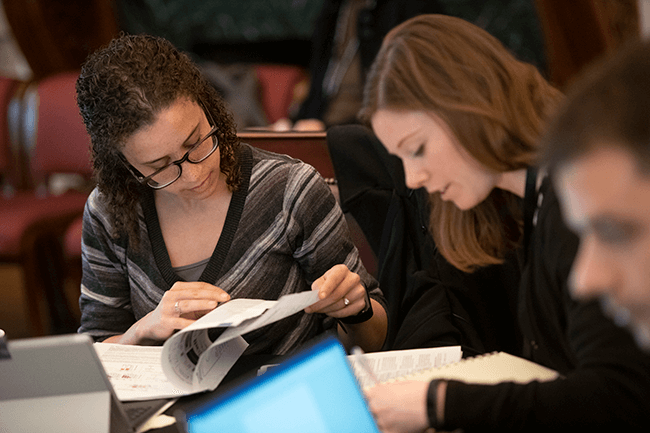
Graduate students Brittany Mayweather and Audrey Sporrij read a scientific journal article as part of a technology marketing case study.
3. Think broadly about the possible applications.
When you’ve invented something to solve a problem in your research, it can be challenging to look beyond that problem to see the many other ways your innovation might be useful. It can be exciting to realize how important your work is to someone else in a field you may have never thought about.
“There are a lot of applications if you step back and think more creatively,” said Jen Rice, a Director of Business Development in OTD. Of course, she added, “You may need to do a reality check on some of these applications that you brainstorm.”
As an example, research associate Tanya Shirman spoke about how research in Prof. Joanna Aizenberg’s lab on the structure and function of materials found in nature has inspired a new method for rational design of the geometry and composition of catalytic systems. The research team has taken a strategic approach to considering whether these new catalytic materials might be put to best use in applications directed at chemical synthesis, emissions control, green energy, or something else.
4. Focus to identify the right market.
“You have to have a technology that works, but you also have to have a market that can accept the technology,” said Gordon Nameni, Founder and Managing Director at August Brown, a Milwaukee-based technology management consulting firm.
Be open-minded about where you might find that market; your first assumptions might not be correct. Nameni led the boot camp participants through an exercise in lateral thinking and assumption storming to demonstrate key concepts in product development that can help lead you to the right product-market fit.
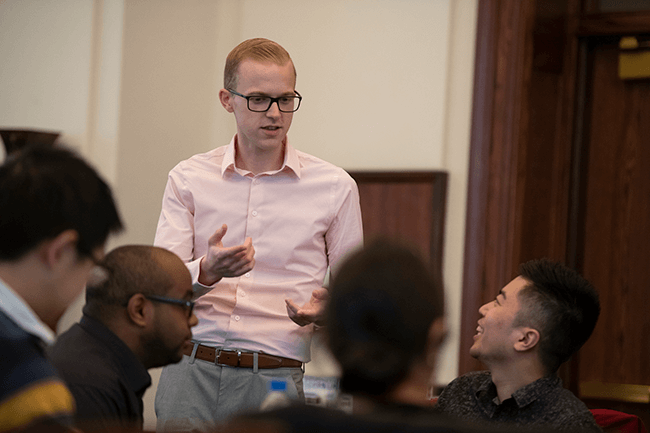
Tyler Brown, a graduate student in engineering sciences and OTD's Senior Business Development Fellow, assists participants with a case study.
5. Study up…
To familiarize yourself with relevant companies, industries, and markets, take advantage of the resources at Harvard’s libraries. Curriculum Services Specialist Mallory Stark and Information Research Specialist Poping Lin, who work at Harvard Business School’s Baker Library, suggested several databases to dig into:
- To identify key players, partners, and competitors, try Capital IQ, Preqin, or Thomson One
- To understand industries and markets, try BCC, Frost & Sullivan, or Thomson One
- For a topical deep dive, try ABI/ProQuest, Compendex, or ScienceDirect
- Or to evaluate small and private companies, try Biocentury Innovations, InVivo & Medtech Pharma Intelligence, or Factiva, as well as industry associations, government databases, and news reports.
6. …and then step away from your desk.
As Shirman pointed out, market research is really just a hypothesis. To validate that hypothesis, you need to talk to real customers — and more than a few. Programs like the National Science Foundation’s seven-week I-Corps program encourage scientific entrepreneurs to engage in hundreds of customer interviews to thoroughly understand what the market needs.
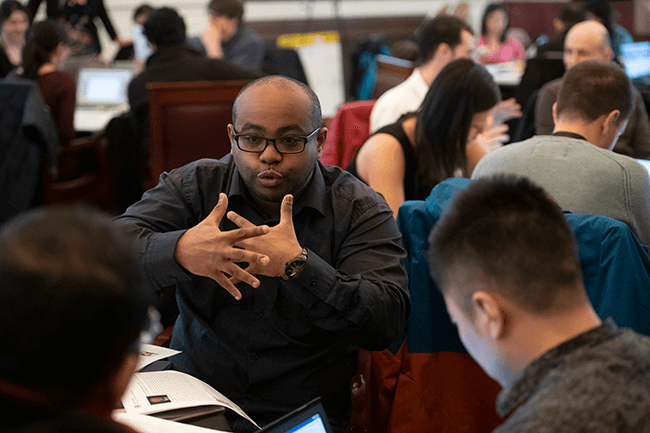
Raie Bekele is a postdoctoral research fellow in medicine at Dana-Farber Cancer Institute.
7. Lean on your network.
Aldatu Biosciences cofounder David Raiser, PhD ’15, was asked about the one thing he would have done differently in launching his company, given the opportunity. He said he regretted not reaching out for help and guidance at an earlier stage — “and doing it often.”
Useful resources are available everywhere you turn. The role of OTD’s business development team is to help Harvard researchers develop and execute a commercialization strategy for their innovations, so don’t be afraid to reach out. Also check out OTD’s Experts in Residence, Entrepreneurs in Residence, and online resources; take advantage of the Harvard Innovation Labs; or build connections through the Harvard Health Innovation Network — to name just a few starting points.
8. Communicate the value of your ideas.
Postdocs and graduate students know that part of being a scientist is learning to communicate technical ideas to colleagues, to journal editors, and to the public. Pitching an idea in a business context, however, requires an entirely different mindset.
“You want to talk about what the opportunity is,” said Grant Zimmermann, a Director of Business Development in OTD. What problem will you solve? What, specifically, are you offering? How is it better than the alternatives? What do you want from the person you’re pitching? Do some research on the person beforehand, to understand their interests and their level of technical knowledge. “You want to be as respectful as you can of people’s time,” Zimmermann said. “Start with the conclusion; say that first, and then get them to read why that’s true.”
During the boot camp, participants drafted elevator pitches for real Harvard innovations and shared them with a panel of industry experts for live feedback. On these first drafts, one piece of feedback was recurrent: Once a patent application has been filed, don’t be unnecessarily secretive about details of your technology that are relevant and publicly available. Transparency will help you establish credibility.
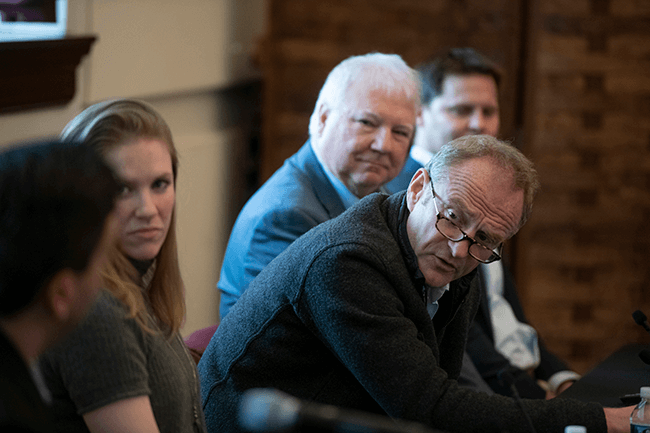
Industry panelists gave critical feedback on the participants' elevator pitches. Marcus Lovell Smith (center), former CTO of Google Fiber, is currently an OTD Entrepreneur in Residence.
9. Build the right entrepreneurial team.
If you’re planning to launch a startup, the people who join your team can help it sink or swim.
“Backing a team with an ability to adapt is really important for us,” said John Lee, Principal at Osage University Partners. Compared to the rest of a founding team, he added that the CEO receives 95% of the scrutiny when a venture firm is considering an investment. A great CEO, according to Lee, will have the vision and drive to lead, be realistic and modest, be adept at motivating others and communicating well, be competitively ambitious without too much ego, and be perceptive and adaptable. (Easy, right?)
Positive team dynamics are essential. Raiser said he was fortunate, in founding Aldatu Biosciences, that his cofounder became his best friend. That’s not always the case. “As a small team, the wrong person [can become] so much more toxic, so being very careful about finding the right people… is really important,” he said. Looking back on his experience, Raiser added, “We would not be where we are today without the founders, employees, advisors, and mentors that we’ve had.”
10. Take inspiration back to your own research.
“I want you to connect to this from a deeper place,” said Isaac Kohlberg, Harvard’s Chief Technology Development Officer and Senior Associate Provost. “While you’re getting to learn about these tools and asking mundane practical questions on IP and deal structure, always connect to why we are doing this. Without this innovation from bench to business, we do not believe that research will really have the maximal impact that it could have, and should have, on society. Without these partnerships, technologies may stay on the shelf.”
And take inspiration from the stories of the innovators who precede you. As Kohlberg put it, “Look at this boot camp as a window to your next step in life.”
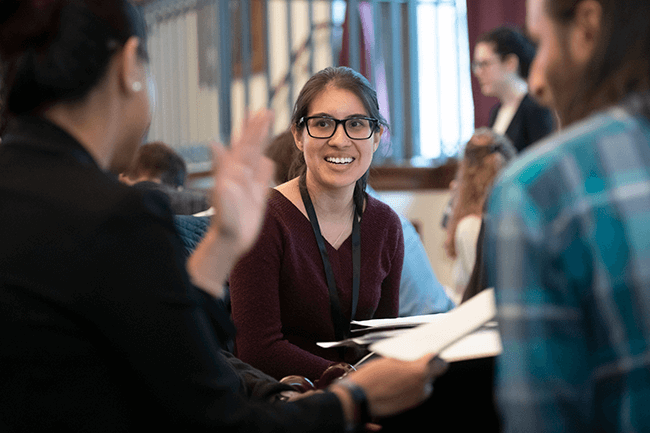
Denise Sirias, a graduate student in molecular and cellular biology, discusses a technology case study with other participants at the table.
Press Contact: Kirsten Mabry | (617) 495-4157
